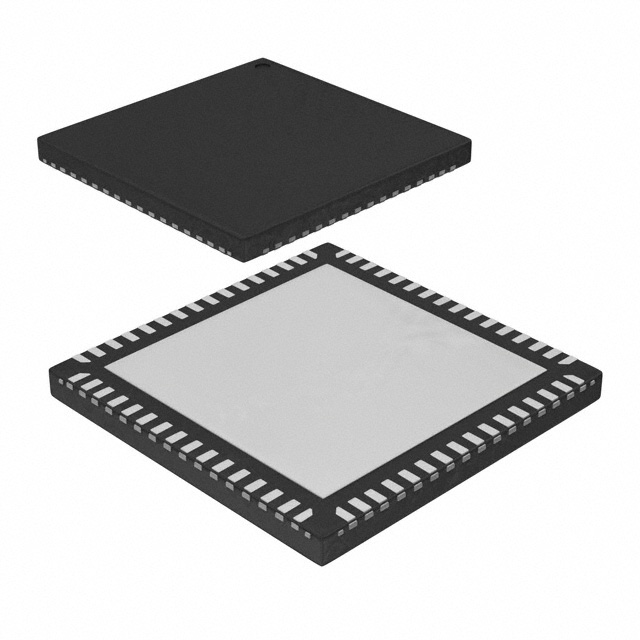ATSAM3N4BA-MU
Product Overview
Category
The ATSAM3N4BA-MU belongs to the category of microcontrollers.
Use
This microcontroller is commonly used in various electronic devices and systems for controlling and processing data.
Characteristics
- High-performance 32-bit ARM Cortex-M3 processor
- Flash memory capacity of 256KB
- SRAM capacity of 48KB
- Operating voltage range: 1.62V to 3.6V
- Low power consumption
- Multiple communication interfaces (UART, SPI, I2C)
- Rich set of peripherals (ADC, PWM, timers)
Package
The ATSAM3N4BA-MU is available in a compact QFN package, which ensures easy integration into circuit boards.
Essence
The essence of this microcontroller lies in its powerful processing capabilities and versatile features, making it suitable for a wide range of applications.
Packaging/Quantity
The ATSAM3N4BA-MU is typically packaged in reels or trays, with a quantity of 2500 units per reel/tray.
Specifications
- Microcontroller architecture: ARM Cortex-M3
- Clock speed: Up to 64MHz
- Flash memory: 256KB
- SRAM: 48KB
- Operating voltage: 1.62V to 3.6V
- Communication interfaces: UART, SPI, I2C
- Peripherals: ADC, PWM, timers
- Package type: QFN
- Package dimensions: 7mm x 7mm
- Temperature range: -40°C to +85°C
Detailed Pin Configuration
The ATSAM3N4BA-MU has a total of 64 pins, each serving a specific purpose. The pin configuration is as follows:
- Pin 1: VDDIO
- Pin 2: PA0
- Pin 3: PA1
- ...
- Pin 64: GND
For a complete pin configuration diagram, please refer to the datasheet provided by the manufacturer.
Functional Features
The ATSAM3N4BA-MU offers several functional features that enhance its performance and usability:
- High-performance processor: The ARM Cortex-M3 processor provides efficient and reliable processing capabilities.
- Ample memory: With 256KB of flash memory and 48KB of SRAM, the microcontroller can handle complex tasks and store data effectively.
- Versatile communication interfaces: The UART, SPI, and I2C interfaces enable seamless connectivity with other devices and systems.
- Rich set of peripherals: The microcontroller's ADC, PWM, and timers allow for precise control and measurement in various applications.
- Low power consumption: The ATSAM3N4BA-MU is designed to minimize power consumption, making it suitable for battery-powered devices.
Advantages and Disadvantages
Advantages
- Powerful processing capabilities
- Ample memory for data storage
- Versatile communication interfaces
- Rich set of peripherals for enhanced functionality
- Low power consumption for energy efficiency
Disadvantages
- Limited availability of alternative models
- Relatively higher cost compared to some other microcontrollers
Working Principles
The ATSAM3N4BA-MU operates based on the principles of the ARM Cortex-M3 architecture. It executes instructions stored in its flash memory, processes data using its internal resources, and communicates with external devices through various interfaces. The microcontroller's working principles revolve around efficient data processing, control, and communication.
Detailed Application Field Plans
The ATSAM3N4BA-MU finds application in various fields, including but not limited to:
- Industrial automation: Controlling and monitoring machinery and equipment.
- Internet of Things (IoT): Enabling connectivity and data processing in IoT devices.
- Consumer electronics: Powering smart home devices, wearable technology, and multimedia systems.
- Automotive: Implementing control systems for vehicles, such as engine management and infotainment.
- Medical devices: Facilitating data acquisition and processing in medical equipment.
Detailed and Complete Alternative Models
While the ATSAM3N4BA-MU is a reliable microcontroller, there are alternative models available that offer similar functionality. Some notable alternatives include:
- STM32F103C8T6: A popular microcontroller with an ARM Cortex-M3 processor and comparable features.
- PIC32MX270F256B: Another microcontroller with a 32-bit MIPS processor and extensive peripheral options.
- LPC1768: An ARM Cortex-M3 based microcontroller with a wide range of communication interfaces and memory capacity.
These alternative models can be considered based on specific project requirements and availability.
In conclusion, the ATSAM3N4BA-MU is a high-performance microcontroller with versatile features and a wide range of applications. Its powerful processing capabilities, ample memory,
قم بإدراج 10 أسئلة وإجابات شائعة تتعلق بتطبيق ATSAM3N4BA-MU في الحلول التقنية
Sure! Here are 10 common questions and answers related to the application of ATSAM3N4BA-MU in technical solutions:
Q: What is ATSAM3N4BA-MU? A: ATSAM3N4BA-MU is a microcontroller unit (MCU) from the SAM3N series by Microchip. It features an ARM Cortex-M3 core and is commonly used in various technical solutions.
Q: What are the key features of ATSAM3N4BA-MU? A: Some key features of ATSAM3N4BA-MU include a 64KB flash memory, 16KB SRAM, multiple communication interfaces (UART, SPI, I2C), analog-to-digital converters (ADC), timers, and GPIO pins.
Q: What applications can ATSAM3N4BA-MU be used for? A: ATSAM3N4BA-MU can be used in a wide range of applications such as industrial automation, consumer electronics, smart energy management, home automation, and Internet of Things (IoT) devices.
Q: How can I program ATSAM3N4BA-MU? A: ATSAM3N4BA-MU can be programmed using various development tools and software, such as the Atmel Studio IDE or third-party tools like Keil MDK or IAR Embedded Workbench.
Q: What programming language is commonly used with ATSAM3N4BA-MU? A: The most commonly used programming language for ATSAM3N4BA-MU is C/C++. However, other languages like assembly language can also be used for specific tasks.
Q: Can ATSAM3N4BA-MU communicate with other devices? A: Yes, ATSAM3N4BA-MU supports multiple communication interfaces like UART, SPI, and I2C, allowing it to communicate with other devices such as sensors, displays, and external memory.
Q: How can I power ATSAM3N4BA-MU? A: ATSAM3N4BA-MU can be powered using a regulated power supply within the specified voltage range (typically 1.62V to 3.6V) or through USB if available.
Q: Does ATSAM3N4BA-MU have built-in security features? A: Yes, ATSAM3N4BA-MU provides various security features like a hardware encryption engine, secure boot, and tamper detection mechanisms to enhance the security of your application.
Q: Can I use ATSAM3N4BA-MU in battery-powered applications? A: Yes, ATSAM3N4BA-MU is designed to be power-efficient and can be used in battery-powered applications. It offers low-power modes and features to optimize energy consumption.
Q: Are there any development boards available for ATSAM3N4BA-MU? A: Yes, Microchip offers development boards like SAM3N-EK and Xplained Pro boards that are compatible with ATSAM3N4BA-MU, providing an easy way to prototype and develop applications.
Please note that these answers are general and may vary depending on specific requirements and use cases.


